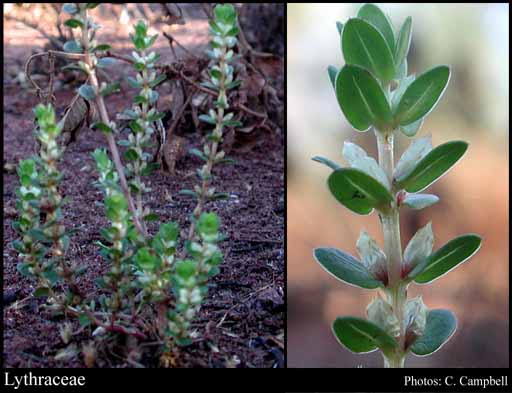- Reference
- Expos.Fam.Nat. 2:175 (1805)
- Name Status
- Current

Scientific Description
Common name. Loosestrife Family.
Habit and leaf form. Herbs (mostly), or shrubs, or trees. Young stems cylindrical, or tetragonal. Hydrophytic (in Rotala), or helophytic to xerophytic. Leaves opposite (usually), or alternate, or whorled; when alternate, spiral; petiolate to sessile; gland-dotted, or not gland-dotted; simple. Leaf blades entire; pinnately veined; cross-venulate. Leaves with stipules (the stipules small), or without stipules. Leaf blade margins entire. Leaves without a persistent basal meristem. Stem anatomy. Nodes unilacunar (usually), or tri-lacunar. Secondary thickening developing from a conventional cambial ring.
Reproductive type, pollination. Fertile flowers hermaphrodite. Unisexual flowers absent. Plants hermaphrodite. Plants homostylous (mostly), or heterostylous (several genera, e.g. Pemphis, Adenaria). Entomophilous.
Inflorescence and flower features. Flowers solitary, or aggregated in ‘inflorescences’; in cymes, in panicles, in racemes, and in verticils. The terminal inflorescence unit cymose, or racemose. Inflorescences terminal, or axillary. Flowers two bracteolate; minute to medium-sized; regular to very irregular. The floral asymmetry when apparent, involving the perianth and involving the androecium. Flowers usually 4 merous, or 6 merous; cyclic, or partially acyclic. When partially non-cyclic, the androecium acyclic. Flowers when fully cyclic, usually pentacyclic. Floral receptacle developing an androphore, or with neither androphore nor gynophore. Free hypanthium present (this elongated, sometimes with a posterior spur). Hypogynous disk or a unilateral gland (Cuphea) present (around G), or absent. Perianth with distinct calyx and corolla (usually), or sepaline (C rarely absent); (3–)8–16(–32); 2 -whorled (usually), or 1 -whorled; isomerous. Calyx (3–)4, or 6, or 8(–16); 1 -whorled; polysepalous (sometimes?), or gamosepalous (usually? — the corolla usually described as inserted ‘in the throat of the calyx’); lobes valvate; tubular, or campanulate, or urceolate (rarely); unequal but not bilabiate, or regular; persistent. Epicalyx present (commonly), or absent. Corolla (3–)4, or 6, or 8(–16); 1 -whorled; polypetalous (at the mouth of the hypanthium); plicate; unequal but not bilabiate, or regular; often red, or purple, or orange. Petals clawed, or sessile. Androecium (4–)8–16(–100) (usually twice K or C, sometimes ‘many’). Androecial sequence determinable, or not determinable. Androecial members when numerous, maturing centripetally (or the outer cycle initiating first); adnate (to the hypanthium, low down); all equal, or markedly unequal; free of one another; 1–3 -whorled (or several). Androecium usually exclusively of fertile stamens. Stamens (4–)8–16(–35); reduced in number relative to the adjacent perianth to isomerous with the perianth to polystemonous; alternisepalous, or oppositisepalous; inflexed in bud (usually), or erect in bud. Anthers dorsifixed; versatile (mostly), or non-versatile (Crenea, Pleurophora); dehiscing via longitudinal slits; introrse; tetrasporangiate. Gynoecium 2–4(–6) carpelled. The pistil 1 celled, or 2–4(–6) celled. Gynoecium syncarpous; eu-syncarpous; superior. Ovary unilocular, or plurilocular; 1 locular (rarely), or 2–4(–6) locular (but sometimes with the septa not reaching the top); sessile to stipitate (stipitate in Lagerstroemia, Diplusodon, Peplis etc.). Gynoecium stylate, or non-stylate to stylate. Styles 1; apical. Stigmas 1; usually capitate; wet type (known only in Lagerstroemia), or dry type (recorded in 13 genera); papillate; Group II type. Placentation rarely (i.e.when unilocular), parietal; usually axile. Ovules (1–)5–50 per locule (usually ‘many’); ascending, or horizontal; non-arillate; anatropous.
Fruit and seed features. Fruit non-fleshy; dehiscent, or indehiscent; a capsule, or capsular-indehiscent. Capsules septicidal, or loculicidal, or circumscissile, or splitting irregularly. Seeds non-endospermic; winged (in a few genera, the wing unilateral in Lagerstroemia, encircling in Lafoensia, Galpinia etc.), or wingless (in most genera). Cotyledons 2. Embryo achlorophyllous (2/3); straight. Seedling. Germination phanerocotylar.
Physiology, biochemistry. Aluminium accumulation not found. Photosynthetic pathway: C3.
Geography, cytology, number of species. World distribution: cosmopolitan, except frigid regions. X = 5–11. 580 species.
Keys
Western Australian Genera and Families of Flowering Plants — an interactive key
T.D. Macfarlane, L. Watson, N.G. Marchant